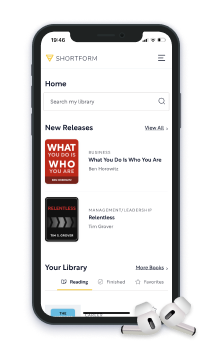

This article gives you a glimpse of what you can learn with Shortform. Shortform has the world’s best guides to 1000+ nonfiction books, plus other resources to help you accelerate your learning.
Want to learn faster and get smarter? Sign up for a free trial here .
What are the best sales methods? How can you decide which method is best for your business?
A sales method is a set of rules you use to determine how to sell a product or service to customers. Now that the traditional sales model is barely effective in the digital age, many businesses are searching far and wide for modern methods to stand out in the consumer market.
Here’s a basic rundown of six popular sales methods so you can decide which one works best for your business rather than relying on the dying traditional sales model.
The Downfall of the Traditional Sales Method
The first widely used sales model was developed in the 1920s by E.K. Strong, and it was practiced with few changes for the next 60 years. Strong’s sales model established the basic ideas of traditional selling, such as using open and closed questions, presenting product features and benefits, handling objections, and using closing techniques.
In the book Purple Cow, Seth Godwin further goes into detail about the fall of traditional sales strategies. During the Age of Advertising, traditional mass marketing was king. The winning strategy was to put your ads in front of as many people as possible, and trust that they would want your product and be willing to pay for it.
Traditional mass marketing runs on the “5 Ps”—there are a lot more than 5, but everyone has their 5 favorites.
Some of these Ps might include:
- Product: What are you selling?
- Publicity: How will you draw attention to your product?
- Pricing: How much will it cost?
- Packaging: What will it look like?
Whichever 5 you use, they’re meant to be a quick checklist to make sure that your marketing is effective and appropriate for what you’re selling. However, the 5 Ps aren’t enough anymore.
First of all, the obvious targets for mass marketing are gone. For example, think about Aspirin, the first major pain reliever on the market. It was cheap, was low risk, had obvious benefits, and almost everyone needed it sooner or later. Perhaps most importantly, it had no competition. It was a perfect candidate for mass marketing. Now, though, there are dozens of painkillers out there. A new one would have a hard time finding traction in that crowded market, even if it is somehow a little better than the others.
Second, consumers will ignore you. This is a relatively new phenomenon; even twenty years ago consumers had more free time, more available money, and fewer choices in what to buy. There were fewer things to spend money on but, at the same time, people’s needs were mostly met. Therefore, business became about selling people what they want, and marketing got them to want more and more. Today, the number of choices people have keeps increasing, but the time and money to sort through them all keep decreasing.
The third problem is that customers who are already satisfied aren’t likely to spread new ideas. Phrased another way, people who are happy with what they have aren’t looking for new products or services. To compound this problem, companies are constantly getting better at knowing what their customers want and delivering it. This makes it harder and harder for newcomers to get people’s attention.
Thankfully, industry professionals have generated new sales methodologies that create solutions to the issues described above. Let’s explore six sales methods to help you decide which one fits best for your business.
SPIN Selling
In the 1990s, the traditional model started becoming less effective as sales grew in price and complexity. SPIN Selling by Neil Rackham created a new sales method for larger sales, based on research into what top salespeople were doing.
Rackham, the founder of Huthwaite International, a research and consulting firm, analyzed over 35,000 sales calls over 12 years. This study, the largest and most rigorous study ever done to that point, found that winning major sales requires applying different skills and asking customers different types of questions. Further, the techniques and strategies effective in small sales can be a hindrance in large sales.
Rackham developed and extensively tested a new model for major sales, SPIN Selling, which uses a questioning method capsulized by the acronym SPIN: S-Situation, P-Problem, I-Implications, and N-Need-Payoff.
Here are the four SPIN questions in more detail:
1) S-Situation questions: Start by asking fact-finding and background questions, such as, “What do you see as the company’s biggest growth opportunities?” Asking too many of these questions can impose on the customer’s time and patience, so use them judiciously.
2) P-Problem questions: Once you understand the customer’s situation, ask questions that explore problems or issues your product or solution can solve—for instance, “Are you concerned about meeting your clients’ quality standards with your aging equipment?” Less experienced reps don’t ask enough of these questions.
3) I-Implication questions: Asking good situation-and-problem questions may be enough to win a small, uncomplicated sale. However, you need to go further in large sales and ask more sophisticated questions that explore the implications or ramifications of a customer’s problem—for example, “How will this affect your fourth-quarter results?” or “What will this mean for your biggest customer?” The point is to underscore a problem’s significance and create an urgency to address it. These are more difficult questions to frame, even for experienced salespeople.
4) N-Need-payoff questions: These questions lead the customer to articulate the benefits of your product or solution. For example, you might ask, “How useful would it be if we could increase your output by 10%?” or “How would being able to reduce errors help you?” When the customer links the value of solving a problem with the capabilities of your product, he’s more inclined to accept your product as the best solution. Need-payoff questions contribute strongly to success in large sales.
The Straight Line Persuasion System
Jordan Belfort is famous mostly for his copious drug use and philandering, as depicted in Martin Scorsese’s film The Wolf of Wall Street. But behind all of that flash is the sales method that propelled him to success. In his book, Way of the Wolf, Belfort calls this method the Straight Line Persuasion System, and it can be used to sell products that benefit both the seller and the buyer.
Even though selling comes innately to him, Belfort believes that he can turn anyone, even those not gifted with his talents, into a world-class salesperson very quickly. He created the system after Black Monday in the Spring of 1988 and started teaching mostly working-class young men and women to be exceptional closers.
Belfort claims that every prospect for a sale is going to fall somewhere between absolutely uncertain and absolutely certain about your product, you, and your company. The goal is to move the customer’s level of certainty throughout the sale so that by the end, they buy.
Five elements must be considered if you implement the Straight Line Persuasion System into your business. The first are the three tens, which attempt to move the customer’s certainty, and the last two deal with the prospect’s state of mind.
The Three Tens
Three elements have to line up, no matter the situation, for you to have a chance at closing a sale. These are called the three tens because you rate certainty on a scale of 1 to 10. If a prospect is at a 10, then they are absolutely certain. If they are at a 1, they are absolutely uncertain. You want to get your prospect to a 10.
- The first ten is the product.
- Your prospect has to be certain that he loves whatever it is that you are selling. He has to be on the right of the scale, saying something along the lines of, “Your product fits all of my needs, and it’s a great value.”
- But even if your prospect is at a 10 with the product, it’s not at all certain that they will buy the product. This brings us to ten number two.
- The second ten is you and the trust you provide.
- If the prospect thinks you’re completely likable and have their best interests in mind, they’ll be at a 10.
- Even if you are close to or at the top of the scale on both of the first two tens, the prospect won’t necessarily buy from you. You need the third ten.
- The third ten is the trust of your company.
- No matter how much the prospect likes you and your product, if they have a bad feeling about your company, they won’t buy from you. This is why it’s easier to sell to existing customers, because they already have a positive relationship with the company, so you only need to work on the first two points.
- If your prospect has a good feeling about your company going into the sale, they’re also likely to have a good feeling about you and your product. They’ll be more naturally trusting because they’ve heard or know good things about your brand. It works the other way around too—if they don’t like your company, they’re much less likely to like you and your product.
The Remaining Elements of the System
The fourth and fifth elements of the Straight Line Persuasion System have to do with the prospect’s state of mind.
- Four: Work to lower the action threshold.
- Even after you’ve done your best to raise the three tens as close to the right as possible, and it seems like they’re ready to buy, sometimes the prospect just won’t. This is because each individual has different beliefs about decision-making and trusting salespeople in general. Each prospect has to cross their own threshold of certainty, or action threshold. The harder someone is to sell to, the higher their action threshold. But these action thresholds can change. Sellers can work to lower them.
- Five: Work to heighten the pain threshold.
- Similar to the action threshold is the pain threshold. Pain is a powerful motivator and creates urgency, which helps close difficult sales. This is why you need to understand what your prospect’s pain is (why they need your product) and where it originates.
Think of the prospect like a complicated safe, where every action you perform helps break one of the five numbers in the lock. The Straight Line Persuasion System is a fantastic set of tools, so long as you take control immediately during the sale. Every sale is the same because, by taking control, you make every sale the same.
Creating a Purple Cow
Seth Godin explains how and why he developed the Purple Cow sales method in his book Purple Cow. Godin and his family were taking a road trip through France. While driving through the countryside they were delighted to see fields full of cows. They hadn’t seen many cows before, so seeing entire herds was quite a novelty for them.
However, the novelty quickly wore off. Every cow looked much like the others, and it didn’t take long for these plain brown cows to become commonplace and boring. But if they were to see a purple cow, that would be remarkable—for a while, at least. You can apply that same concept to marketing.
The point of marketing is to catch people’s attention and to get them interested in your product. However, so much of marketing consists of regular old brown cows; the ads (and the products) all look the same. They’re not remarkable enough to pull people away from their busy lives and trusted products or services. That’s why you need a Purple Cow: something truly remarkable that will catch people’s interest.
Finding Your Purple Cow
Finding your Purple Cow is the first step of Godin’s sales method, and it’s a matter of looking for extremes. Take a look at your products, your advertisements, your image, even your pricing, and ask yourself: What are the absolute limits of possibility? For example, one limit of pricing would be giving your product away for free. It would certainly be remarkable, though it might not get the results you want. A limit of design might be something so incredibly eye-catching that people are interested just from seeing your product, without any need for advertising.
You won’t necessarily be going to those limits, but you need to see where they are (and where your competitors are) to make a plan. Finding the right limit to go to is one of the most surefire ways to make a Purple Cow.
In today’s world of brown cows, playing it safe is risky. Making a middle-of-the-road product with broad appeal will all but guarantee that nobody notices it, and trying to copy someone else’s success is equally ill-fated. If your product is just playing follow-the-leader, then by definition it isn’t remarkable (unless you have some great new innovation building off of that other product). You need something that will stand out, something that’ll catch the attention of the innovators and early adopters who will pass it on to others.
What to Do With the Cow
There are two goals once you have an established Purple Cow:
- Milk it. Try to get as much out of your Cow as you can for as long as possible. However, recognize that the Cow won’t last forever, and that’s where the second goal comes in.
- Work to create a new Purple Cow—or at least create a work environment where it’s likely that you’ll make another. This means investing in new projects and innovations, encouraging creativity, and resisting the urge to stifle creativity with compromises.
There is a four-step process to pursue both goals at once, and keep the Purple Cow cycle going:
- Once innovators and early adopters pick up your product, get permission from those new fans to let them know the next time you might have a new Purple Cow. Don’t spam them! Only contact them when you’ve got something that’s worth their time.
- Work with those innovators and early adopters to help them reach more people. Give them the tools and the slogans they need to spread the word about your Cow.
- Once your Purple Cow is established, hand it off to a different team to milk it. Squeeze everything you can out of your product or service, and do so quickly before it’s no longer remarkable.
- Reinvest your profits into making a new Purple Cow, bigger and better than the last one. Fail as many times as it takes. A new success will be worth the failures.
Keeping this cycle going is the key to keeping your business thriving.
The Challenger Sales Method
During the 2008-09 recession, business dried up for most sales reps. Yet a handful succeeded in selling despite the downturn. Researchers with the business advisory firm CEB set out to learn these reps’ secrets to selling in bad times by surveying thousands of sales reps in companies around the world.
As it turned out, the reps’ success had nothing to do with the economy and everything to do with the fact that they responded to customers’ needs in a new way: they pushed customers to think and act differently. In The Challenger Sale, authors Matthew Dixon and Brent Adamson of CEB’s research arm explain this new sales method and how to replicate it in your sales force.
Characteristics of a Challenger
Challenger skills drive sales success because they dovetail with what research has shown customers want most.
CEB research shows that the most important thing to customers is the sales experience—not the product, service, or price. Customers want to learn something in the sales interaction more than they want to buy something. They want insight into how to cut costs, make more money, and reduce risk.
Therefore, customers value reps most who:
- Offer unique and valuable perspectives on the market
- Help them navigate alternatives
- Provide advice
- Help them avoid potential problems
- Educate them on new issues and outcomes
These attributes above reflect three key abilities that define Challengers: teaching, tailoring, and taking control.
Let’s go more in-depth on the fundamental abilities of the Challenger Sales Method.
Teaching
Effective teaching often means providing a key insight that challenges the customer’s assumptions. It shows a problem that the customer didn’t know they had or highlights the shortcomings of other approaches. The reaction you’re going for is, “I never thought of it that way before”—“not I totally agree,” which signals agreement but not novel insight.
An effective teaching conversation follows six steps:
- The warm-up: Present your assessment of the key issues facing the customer based on what you’ve seen at similar companies and get the customer’s reaction.
- Reframing: Offer a new insight that connects the issues to a bigger problem or opportunity. Don’t go into detail—just give the headline to pique the customer’s curiosity.
- ‘Rational drowning’: Present your data to build the business case for why the reframe deserves the customer’s consideration. Subject the customer to “rational drowning”—that is, present the rationale for a new approach in a way that makes her uncomfortable with her current approach and therefore open to the new approach.
- Emotional impact: Ensure that the customer connects emotionally with the issue. Tell a story about another company that thought the same way as the customer, failed to take action, and suffered.
- A new way: Review the capabilities the customer needs to solve the problem. Show the customer how much better her life would be if she acted differently. She has to accept the solution before buying your solution
- Your solution: Demonstrate that your company’s solution is the answer. Explain specifically how your company is best positioned to deliver the solution they’ve agreed to.
Tailoring
The way to build the broad consensus necessary to win a deal is to tailor the teaching message so that it resonates and sticks with each stakeholder.
To tailor a message to a particular stakeholder, the rep needs to understand:
- The stakeholder’s specific business priorities
- The outcomes the person cares most about
- The results they have to deliver (how their performance is measured)
- The economic drivers affecting those outcomes
For instance, if a rep is talking with the head of marketing, he tailors his message to her priorities. He then changes his tailoring for the head of IT, who has a very different set of priorities.
Taking Control
Being assertive, or taking control, doesn’t mean being aggressive or irritating; it means the rep stands firm when the customer pushes back.
Challenger reps assert themselves in two ways:
- They control the discussion of pricing and money in general. The rep doesn’t give in to the request for a 10% discount, but instead refocuses the conversation on the value of the supplier’s offering, rather than the price.
- They challenge the customer’s thinking and pressure the customer to reach a decision more quickly to counter the inertia that can stall decisions indefinitely. To handle reluctance (risk aversion), the Challenger moves customers out of their comfort zone by presenting things from a different perspective.
Just as you can’t be an effective teacher without pushing your students, you can’t teach customers without pushing them to think and act differently. Reps take the lead with a specific end in mind.
New Sales Driver
Generating new business as a salesperson is essential to a company’s success, yet few salespeople are good at it. Many reps are intimidated by making “cold calls” (first-time calls to potential customers to ask for their business), and therefore, they make only half-hearted attempts or none at all. But “prospecting” for new business isn’t difficult. In New Sales. Simplified., veteran salesman and sales coach Mike Weinberg demystifies prospecting for both veterans and inexperienced salespeople.
Weinberg’s solution to many companies’ and sales reps’ struggle to grow a new business is a three-stage sales method he calls the “New Sales Driver.” The stages of the sales method are:
- Targeting: strategically selecting potential customers to pursue.
- Developing your weapons: creating powerful sales tools and using them effectively.
- Planning and executing: determining which tools to use and when, then executing.
Create a Target List
When choosing your targets, look for potential new customers with a profile similar to that of your best current customers. Ask:
- Who are the company’s best customers?
- What do they have in common?
- What do these companies and their markets look like?
- Where or how can we find potential customers who resemble our best customers?
Developing Your Weapons
Once you have your target list, the next step in generating new business is developing sales weapons or tools. These sales tools and techniques, used proficiently, will differentiate you from your competitors.
1) Your sales story: Your sales story is a compelling, succinct, customer-focused response you give when someone asks you to tell them about your business. An effective story focuses on the problems you solve for customers and the ways your solution is different and better than anyone else’s.
2) The cold call: A cold call is a phone call in which you’re attempting to make your first contact with a prospect. It’s one of the most important and effective ways to get a meeting. While many reps fear making cold calls, you can make these calls with confidence when you know that your target resembles your best customers and you have a compelling sales story to tell.
3) The first face-to-face sales call: Getting an initial meeting with a potential client is the linchpin of new business development. Many reps go into an initial meeting with no structure or plan in mind. They end up talking too much and sounding like every other sales rep. An agenda built around your sales story will differentiate you from competitors.
4) “Discovery” questions: One of the most important parts of a sales meeting with a prospect is asking “discovery” questions to uncover frustrations, problems, and opportunities your solution could address better than anyone else’s. Asking these questions and listening to the answers is more important in the initial sales call than making a great presentation.
5) Case studies: A useful tool in a sales call is having a few case studies of how you’ve helped companies similar to your prospect’s to solve problems and seize opportunities. These examples are strong evidence of the value of your solutions. Similarly effective are third-party testimonials and recommendations, which come across as more credible than touting your own virtues.
6) Team selling: This is when the salesperson is accompanied on a call by senior executives or “subject matter experts” (such as an IT director who can discuss technical details of your solution). Their involvement underscores that you’re committed to getting the prospect’s business.
7) Presentations: Prospects often expect a presentation right off the bat because that’s what most salespeople deliver. However, to make an effective presentation, you first need to ask discovery questions so you can tailor your offering to the client’s needs and interests. A well-planned, customized presentation will make you stand out from the competition.
8) Proposals: Proposals can take various forms. You may have to respond to a formal request for a proposal (RFP). But typically, you’ll have the opportunity to create a tailored proposal for the customer. It’s one of the last tools you’ll apply in the sales process, so it’s important to make it count by sharpening your proposal writing skills.
Planning and Executing
The final step in this new-sales method is planning and executing by pursuing the prospects on your list. Many salespeople like to talk about selling, but when it comes to prospecting, fewer actually do it. Here are three ways to make prospecting a priority and to get it done:
- Time blocking: Time blocking is reserving periods of time for activities that are priorities. Schedule blocks of 90 minutes to two hours at least twice a week for prospecting. (Three hours is probably the maximum you can concentrate and be free of interruptions.)
- Creating a personal business plan: Write a personal business plan annually that places a great emphasis on prospecting. Include the following components in the plan: goals, strategies, actions, hurdles, personal developments.
- Maintaining a balanced “pipeline” or portfolio of accounts: Your pipeline is the accounts you’re working on. Spread your sales efforts over many accounts that are at various stages in the sales process so that hitting your sales goals won’t hinge on one or two accounts that could stall.
Direct-Response Marketing
For a small business, the surest way to make money and grow is to have a simple, clear marketing plan that defines who you’re targeting as prospects and how you’ll reach them. In the book The 1-Page Marketing Plan, business coach and entrepreneur Allan Dib says the most effective sales method for a small business owner is direct-response marketing.
Direct-response marketing is a multifaceted topic that you could spend considerable time studying. But the The1-Page Marketing Plan helps you write and implement a direct-response plan for your business without having to become an expert. Dib’s plan is based on three customer-focused marketing phases: awareness, familiarity, and enthusiasm.
Phase 1—Create Awareness
In the first marketing phase, you want people who’ve likely never heard of your business—prospects—to discover you and respond to an offer, thereby becoming leads and entering the second phase.
The three steps for reaching prospects are:
- Identify your target market.
- Develop a compelling message for this market.
- Deliver the message through some type of direct advertising.
Phase 2—Build Familiarity
The second marketing phase after creating awareness focuses on developing or nurturing sales leads—people who have indicated interest by responding to your message—and turning these leads into customers.
Dib’s three steps for increasing leads’ familiarity with you so they buy your product are:
- Capture leads in a database.
- Cultivate leads—increase their interest with offers that build in value.
- Convert them into customers (get them to like/trust you enough to buy from you, moving into the third phase of the marketing process).
Phase 3—Build Enthusiasm
The final marketing phase after creating awareness and building familiarity focuses on turning customers who’ve bought from you at least once into enthusiastic superfans who keep buying from you and make referrals.
Dib’s three steps for turning customers into superfans are:
- Give them an extraordinary experience.
- Get them to keep buying more from you, increasing their value to your business.
- Get them to make referrals.
Dib notes that most businesses stop marketing to a customer once she buys something—however, this way of thinking limits business growth. Developing customers into superfans generates ongoing revenue and can help you launch new products because superfans will test the products and evangelize for them.
Final Tips
There’s not one particular sales methodology that is considered the “best.” If that were the case, everyone would be using the same method. Instead, you have to research strategies that will satisfy your customers’ and your company’s needs.
The basic rule of thumb: Don’t pick a sales method that’s too simple. Your customers will feel like you’re not putting in the effort and it will drive them away from your product. Customers thrive on the seller-consumer relationship and want to feel that they are of great importance to you. On the other hand, don’t pick a method that’s too flashy and complicated. You’ll end up losing profits for a methodology that is too complex for your employees and customers to understand.
You have to find the right balance. It’s a matter of understanding your company’s values and putting customer service and product sales as a top priority. Carefully picking the sales method that tailors to your business can help increase meaningful customer interactions and wins for your business.

Want to fast-track your learning? With Shortform, you’ll gain insights you won't find anywhere else .
Here's what you’ll get when you sign up for Shortform :
- Complicated ideas explained in simple and concise ways
- Smart analysis that connects what you’re reading to other key concepts
- Writing with zero fluff because we know how important your time is






